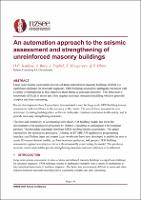| dc.contributor.author | Scullion, Owain | |
| dc.contributor.author | Boys, Alistair | |
| dc.contributor.author | Oliver, Stuart | |
| dc.contributor.author | English, Jack | |
| dc.contributor.author | Hoogeveen, Troy | |
| dc.date.accessioned | 2021-06-22T04:01:54Z | |
| dc.date.available | 2021-06-22T04:01:54Z | |
| dc.date.issued | 2021-04-14 | |
| dc.identifier.uri | https://repo.nzsee.org.nz/xmlui/handle/nzsee/2369 | |
| dc.description.abstract | Large scale seismic assessments in areas of dense unreinforced masonry buildings (URM) is a significant challenge for structural engineers. URM buildings respond to earthquake excitation with a variety of mechanisms as they transition from elastic to nonlinear response. This behaviour is notoriously difficult to assess and often requires nonlinear structural modelling which is generally complex and time-consuming.
Recent developments from Europe have demonstrated a need for large scale URM building seismic assessments with confidence in the accuracy of the results. The aim of these assessments is to determine if existing buildings have sufficient earthquake resistance in relation to life-safety, and to provide necessary strengthening measures.
The time and complexity of constructing individual URM building models has led to the development of an automation procedure by Holmes Consulting in conjunction with our European partners. The procedure automates nonlinear URM building seismic assessments. This paper summarises this automation procedure. Utilising the ETABS API (application programming interface) and Python, input and output Excel workbooks have been developed to enable the user to create 3D macro element models, perform nonlinear pushover, and process URM building assessments against acceptance criteria without manually constructing the model. This produces accurate results and enables precise strengthening measures and cost estimates to be obtained | |
| dc.language.iso | en | |
| dc.publisher | New Zealand Society for Earthquake Engineering | |
| dc.relation.ispartofseries | 2021;0049 | |
| dc.subject | Case studies and research supporting mitigation by retrofitting | |
| dc.subject | Engineering assessments for general purposes and potentially earthquake-prone buildings | |
| dc.subject | Innovative approaches in seismic design and assessment | |
| dc.title | An automation approach to the seismic assessment and strengthening of unreinforced masonry buildings | |
| dc.type | Article | |

